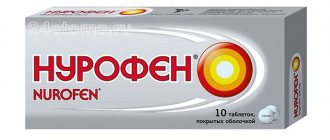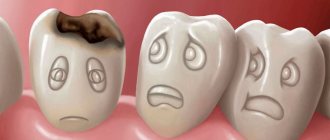Causes of pulpitis
Pulpitis is an inflammation of the pulp, the inner tissue of the tooth . In simpler terms, this is an inflammation of the nerves that are located in the root canals of the tooth.
It occurs as a result of the development of ordinary caries, when it penetrates deeper, moving from the crown to the roots of the teeth.
Diagnosing it yourself, or at least assuming its existence, is quite simple: if a tooth reacts very sharply to cold or hot, sour or salty, then it is the nerve that is reacting , and accordingly, it is the nerve that is inflamed.
Despite the fact that the cause of such sensitivity is often depleted enamel, in any case it is worth contacting a dentist.
Considering the fact that pulpitis is mainly treated using local anesthesia, the occurrence of pain after its treatment is a normal situation, and you should not immediately think that the tooth was poorly cured. Within one or two days, the pain goes away, and the person can again allow himself to eat hard apples, nibble carrots or nuts.
Pulpitis most often occurs due to the lack of timely treatment of deep caries.
The treatment of pulpitis, depending on its stage, is carried out by therapeutic (for mild forms) and surgical dentistry (for severe forms).
If pulpitis is not treated in a timely manner, the tooth may be completely destroyed, which may lead to its removal. More details here: .
However, approximately two thirds of cases of pain after pulpitis treatment are not due to the fact that there was intervention in the inflamed area of the tooth. Very often, a treated tooth begins to ache due to the fact that its treatment did not comply with all the necessary rules.
Signs that the tooth is filled incorrectly include, in addition to pain, swelling of the gums. Although sometimes inflammation can only be diagnosed on an x-ray.
Reason to visit the dentist again
If after treatment for pulpitis you continue to experience pain for a long period of time, it intensifies, the gums become red and/or swollen, or your body temperature rises, you should immediately consult a dentist.
Why shouldn't you put off visiting the doctor? If discomfort in a tooth occurs due to perforation or root fracture, then without adequate therapy the patient may be left without a tooth. And periodontitis can lead to complications such as the formation of cysts and granulomas. Important: the state of health and well-being is affected by a sluggish inflammatory process in the teeth, which is why it is so important to eliminate it in a timely manner.
Some patients, if they are bothered by painful sensations, run to the dentist immediately after therapy. Even if the treatment was performed correctly, pain may persist for several days (up to 3) after the manipulation. Discomfort for several months is considered normal, but only if it gradually subsides and the tooth does not bother you when biting or eating hot/cold food.
Specialist actions
The dentist is obliged to admit the patient and conduct an examination, assess the condition of the tissues that surround the tooth. In this situation, you cannot do without an x-ray. This will allow you to assess the quality of treatment, as well as diagnose complications or their absence.
If the painful sensations are not associated with complications of therapy or pathology, the doctor will prescribe painkillers to the patient and also advise him to monitor his condition.
The examination confirmed the worst assumptions and the patient has complications? In such a situation, the dentist will decide what further treatment tactics should be. The specialist must assess the patient’s condition.
What should you do if the doctor refuses to examine you, convinces you that the therapy was carried out correctly, but does not conduct an examination? In such a situation, you should not give up; you need to visit another doctor who will listen carefully, conduct an examination (if necessary, take a panoramic photo and x-ray). If an inflammatory process was detected during the examination, the dentist will draw up a treatment plan, perhaps this will be surgical therapy. Without this, complications may arise such as:
- periapical abscess;
- periodontitis;
- osteomyelitis;
- orbital cellulitis.
And the spread of infection from the upper teeth is fraught with purulent sinusitis, brain abscess, meningitis and cavernous sinus thrombosis.
Choosing a dental clinic
The Vash Dentist clinic provides high-quality dental services. We employ highly qualified specialists with extensive experience. It's no secret that most dentists, despite modern methods of therapy, still use “old-fashioned” methods of treatment, which most often result in tooth extraction. During treatment, doctors at our clinic use modern technologies, instruments and professional equipment.
We have the necessary certificates and licenses, all services are provided at a high level.
On our website you can find out how therapy is carried out and how much this service costs. On our website you can choose a specialist and make an appointment with him.
If you contact our clinic for treatment of pulpitis, you will not be bothered by pain after therapy. Without fail, the doctor will warn you about what consequences the treatment may entail and give recommendations on how to eliminate them as quickly as possible. If you have any questions after the manipulations, you can always seek qualified advice.
How long does a tooth usually hurt after pulpitis treatment?
What to do if, after treatment of pulpitis, a tooth hurts, and the pain does not go away for several days or even lasts more than a week after the procedure?
Of course, it is best to immediately consult a doctor and treat it. The sooner this happens, the less painful it will be for the patient. It is not recommended to use painkillers, especially strong analgesics. They can cause a powerful blow to the entire body.
It is also not recommended to endure pain, since this will also be stressful for the body. In general, there is only one way out - visiting a doctor. The only case when pulpitis cannot be treated immediately is pregnancy .
Here, as they say, there is a double-edged sword: X-rays, which are mandatory for pulpitis, are strictly prohibited, anesthesia cannot be used, it is also not advisable to endure it, but it is better to choose the lesser of two evils.
Our doctors
18 years of experience
Baghdasaryan
Armen Evgenievich
Chief physician, dentist-orthopedist-therapist
Graduated from VSMA named after. N.N. Burdenko. Internship on the basis of MGMSU named after. A.E. Evdokimov in “General Dentistry”.
Clinical residency at the Moscow State Medical University named after. A.E. Evdokimov in “Orthopedics”.
More about the doctor...
5 years experience
Sadina
Ekaterina Vladislavovna
Dental therapist, surgeon
Penza State University Medical Institute, specialty “Dentistry”.
In 2016, she underwent professional retraining in the specialty “Therapeutic Dentistry” at the Moscow State Medical and Dental University named after A.I. Evdokimov.
More about the doctor...
8 years of experience
Arzumanov
Andranik Arkadievich
Dentist-orthodontist
Graduated from Moscow State Medical University. Internship - Moscow State Medical University at the Department of Orthodontics and Children's Prosthetics.
Residency at Moscow State Medical University at the Department of Orthodontics and Children's Prosthetics. Member of the Professional Society of Orthodontists of Russia since 2010.
More about the doctor...
Symptoms
A distinctive feature of purulent pulpitis is intense pain symptoms. It is caused by the accumulation of pus inside the pulp and its pressure on the nerve. The pain is of a boring nature and is especially intensified at night. The patient experiences a feeling of unpleasant pressure in the tooth. If a spontaneous opening of an abscess occurs, the pain sensations change their character and become dependent on external influences. The patient experiences irradiation of pain throughout the jaw to the ear and temporal region, while they intensify when exposed to high temperatures and, on the contrary, weaken when exposed to low temperatures. In addition, other symptoms are observed:
- swelling of the mucous membrane near the affected tooth;
- bleeding gums in the area of the affected tooth;
- darkening of tooth enamel.
Diagnostics
First of all, the dentist conducts an examination and analyzes the nature of the patient’s pain. If during the examination a painful reaction to probing, a change in the color of tooth enamel, the presence of white plaque, swelling of the mucous membrane and softening of the dentin are revealed, the patient is sent for radiography. Inflammatory processes are clearly visible in the image; in addition, it is possible to find out how far the process has gone. Special attention is paid to the differential diagnosis of pulpitis, since it is very important to distinguish it from the following diseases:
- acute focal and diffuse pulpitis;
- purulent periodontitis;
- trigeminal neuralgia.
What are the causes of pain
The occurrence of pain after treatment of pulpitis after removing nerves and cleaning root canals can be caused by two main reasons. The first is damage to the tissues of the apex of the tooth root, the second is poor-quality filling.
The first reason is quite understandable: when instruments intervene in the internal areas of the tooth, part of the nerve is torn off, and until this place heals, some time must pass. If the tooth itself was treated efficiently, then in a maximum of 3 days the wound inside will heal and the pain will disappear.
But with the second option the situation is more complicated.
There are several options for poor-quality filling of a tooth with pulpitis:
- The dental canal is not completely sealed;
- The canal is sealed too deeply;
- The filling material has gone beyond the root;
- When filling, a piece of the instrument remained inside;
- During the procedure, a perforation of the root canal occurred during cleaning.
It should be noted that the vast majority of such cases occur through the fault of the dentist. I don’t want to talk badly about doctors, but the statistics speak for themselves. In part, such misfires among doctors stem from a lack of experience; it is much worse when their poor-quality work is associated with ordinary negligence.
However, the dentist cannot be blamed if the patient’s root canals are not completely straight: in this case, even an experienced dentist, no matter how hard he tries, can accidentally damage the canal or fill it not to the top. Therefore, in such cases, it is always better to take an X-ray of the tooth.
Let's look at the most common causes of pain after pulpitis treatment.
An incompletely sealed canal
If the canal is not completely sealed, it means that there is free space left in it or the filling material is not placed tightly, and bacteria will continue to develop in this space, even if the canal itself has been well cleaned. They'll get there anyway. The development of this process often smoothly flows into periodontitis (aka abscess).
To prevent infection from entering the space surrounding the treated tooth, it needs to be treated, and, if possible, as quickly as possible.
Otherwise, this may result in tooth loss, and then either prosthetics or empty space. The first is much more expensive and takes longer than treating pulpitis, the second is constant inconvenience and not the most aesthetic appearance.
The filling material has gone beyond the root
The situation opposite to the above is not so critical. Excess filling material is less dangerous. The tooth may hurt for a long time, although not severely.
But, in any case, before retreatment, it is better to take an x-ray. If the doctor did not go too far with the filling, the pain will go away in about a month; if there is a lot of excess material, you can do a simple operation to remove it.
A piece of the instrument remained inside
The third option, a fragment of an instrument in the root canal, is practically the same as an incompletely sealed canal, only there is also a foreign body in addition. The consequences are the same as an abscess, so the tooth must be immediately treated, foreign objects removed, the canal thoroughly cleaned and properly sealed.
Root perforation during the procedure
The most dangerous of all the undesirable consequences of pulpitis treatment is root perforation. This happens mainly when the canals are severely curved, and even if the doctor works carefully, he may accidentally damage it.
The treatment is carried out with special preparations, it can be performed from the inside of the tooth and from the outside, but in general the procedure is quite complicated.
Brief conclusions
The main consequences of poor treatment of pulpitis are as follows:
- flux, formation of cysts in cases where the canals are not completely filled, periodontitis;
- prolonged pain and neuralgia during repeated canal filling.
One of the most unpleasant consequences for the patient is tooth extraction. It cannot be avoided if:
- the doctor during the treatment broke the root or caused a perforation, which was not eliminated as soon as possible;
- A periodontal abscess formed at the root apex, and the patient delayed its treatment.
Clinical researches
Clinical studies have proven that regular use of professional toothpaste ASEPTA REMINERALIZATION improved the condition of the enamel by 64% and reduced tooth sensitivity by 66% after just 4 weeks.
Sources:
- Report on the determination/confirmation of the preventive properties of personal oral hygiene products “ASEPTA PLUS” Remineralization doctor-researcher A.A. Leontyev, head Department of Preventive Dentistry, Doctor of Medical Sciences, Professor S.B. Ulitovsky First St. Petersburg State Medical University named after. acad. I.P. Pavlova, Department of Preventive Dentistry
- Clinical and laboratory assessment of the influence of domestic therapeutic and prophylactic toothpaste based on plant extracts on the condition of the oral cavity in patients with simple marginal gingivitis. Doctor of Medical Sciences, Professor Elovikova T.M.1, Candidate of Chemical Sciences, Associate Professor Ermishina E.Yu. 2, Doctor of Technical Sciences Associate Professor Belokonova N.A. 2 Department of Therapeutic Dentistry USMU1, Department of General Chemistry USMU2
- Clinical experience in using the Asepta series of products Fuchs Elena Ivanovna Assistant of the Department of Therapeutic and Pediatric Dentistry State Budgetary Educational Institution of Higher Professional Education Ryazan State Medical University named after Academician I.P. Pavlova of the Ministry of Health and Social Development of the Russian Federation (GBOU VPO RyazSMU Ministry of Health and Social Development of Russia)










